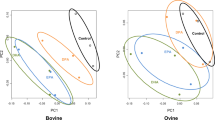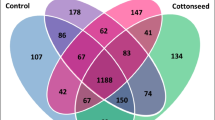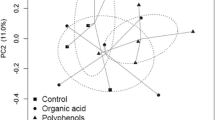Abstract
This study evaluated the effects of selected essential oils on archaeal communities using the ovine rumen model. Forty weaned Canadian Arcott ewes, fed with barley-based diet, were allotted to one of three essential oil supplementation treatments or a control (10 ewes per treatment) for 13 weeks. The treatments were cinnamaldehyde, garlic oil, juniper berry oil, and a control with no additive. Rumen content was sampled after slaughter and grouped by treatment by combining subsamples from each animal. DNA was extracted from the pooled samples and analyzed for methanogenic archaea using quantitative polymerase chain reaction, denaturing gradient gel electrophoresis, cloning, and sequencing. Our results suggest that the total copy number of archaeal 16S rRNA was not significantly affected by the treatments. The phylogenetic analysis indicated a trend toward an increased diversity of methanogenic archaea related to Methanosphaera stadtmanae, Methanobrevibacter smithii, and some uncultured groups with cinnamaldehyde, garlic, and juniper berry oil supplementation. The trends in the diversity of methanogenic archaea observed with the essential oil supplementation may have resulted from changes in associated protozoal species. Supplementation of ruminant diets with essential oils may alter the diversity of rumen methanogens without affecting the methanogenic capacity of the rumen.



Similar content being viewed by others
References
Adetumbi M, Javor GT, Lau BH (1986) Allium sativum (garlic) inhibits lipid synthesis by Candida albicans. Antimicrob Agents Chemother 30:499–501
Altschul SF, Madden TL, Schaffer AA, Zhang J, Zhang Z, Miller W, Lipman DJ (1997) Gapped BLAST and PSI-BLAST: A new generation of protein database search programs. Nucleic Acids Res 25:3389–3402
Angioni A, Barra A, Russo MT, Coroneo V, Dessi S, Cabras P (2003) Chemical composition of the essential oils of Juniperus from ripe and unripe berries and leaves and their antimicrobial activity. J Agric Food Chem 51:3073–3078
Busquet M, Calsamiglia S, Ferret A, Cardozo PW, Kamel C (2005) Effects of cinnamaldehyde and garlic oil on rumen microbial fermentation in a dual flow continuous culture. J Dairy Sci 88:2508–2516
Cannas A, Tedeschi LO, Fox DG, Pell AN, Van Soest PJ (2004) A mechanistic model for predicting the nutrient requirements and feed biological values for sheep. J Anim Sci 82:149–169
Cardozo PW, Calsamiglia S, Ferret A, Kamel C (2004) Effects of natural plant extracts on ruminal protein degradation and fermentation profiles in continuous culture. J Anim Sci 82:3230–3236
Cardozo PW, Calsamiglia S, Ferret A, Kamel C (2006) Effects of alfalfa extract, anise, capsicum, and a mixture of cinnamaldehyde and eugenol on ruminal fermentation and protein degradation in beef heifers fed a high-concentrate diet. J Anim Sci 84:2801–2808
CCAC (1993) Guide to the care and use of experimental animals. Canadian Council on Animal Care, Ottawa, ON, Canada
Chang ST, Chen PF, Chang SC (2001) Antibacterial activity of leaf essential oils and their constituents from Cinnamomum osmophloeum. J Ethnopharmacol 77:123–127
Cole JR, Chai B, Marsh TL, Farris RJ, Wang Q, Kulam SA, Chandra S, McGarrell DM, Schmidt TM, Garrity GM, Tiedje JM (2003) The Ribosomal Database Project (RDP-II): Previewing a new autoaligner that allows regular updates and the new prokaryotic taxonomy. Nucleic Acids Res 31:442–443
Czerkawski JW (1969) Methane production in ruminants and its significance. World Rev Nutr Diet 11:240–282
Daniels L, Zeikus JG (1978) One-carbon metabolism in methanogenic bacteria: Analysis of short-term fixation products of 14CO2 and 14CH3OH incorporated into whole cells. J Bacteriol 136:75–84
Dorman HJ, Deans SG (2000) Antimicrobial agents from plants: Antibacterial activity of plant volatile oils. J Appl Microbiol 88:308–316
Felsenstein J (1993) PHYLIP (Phylogeny Inference Package) version 3.5c. Department of Genetics, University of Washington, Seattle
Fricke WF, Seedorf H, Henne A, Kruer M, Liesegang H, Hedderich R, Gottschalk G, Thauer RK (2006) The genome sequence of Methanosphaera stadtmanae reveals why this human intestinal archaeon is restricted to methanol and H2 for methane formation and ATP synthesis. J Bacteriol 188:642–658
Fromin N, Hamelin J, Tarnawski S, Roesti D, Jourdain-Miserez K, Forestier N, Teyssier-Cuvelle S, Gillet F, Aragno M, Rossi P (2002) Statistical analysis of denaturing gel electrophoresis (DGE) fingerprinting patterns. Environ Microbiol 4:634–643
Galtier N, Gouy M, Gautier C (1996) SeaView and Phylo_win, two graphic tools for sequence alignment and molecular phylogeny. Comput Appl Biosci 12:543–548
Gill AO, Holley RA (2004) Mechanisms of bactericidal action of cinnamaldehyde against Listeria monocytogenes and of eugenol against L. monocytogenes and Lactobacillus sakei. Appl Environ Microbiol 70:5750–5755
Hammer KA, Carson CF, Riley TV (1999) Antimicrobial activity of essential oils and other plant extracts. J Appl Microbiol 86:985–990
Hino T, Russell JB (1985) Effect of reducing-equivalent disposal and NADH/NAD on deamination of amino acids by intact rumen microorganisms and their cell extracts. Appl Environ Microbiol 50:1368–1374
Horton GM (1980) Use of feed additives to reduce ruminal methane production and deaminase activity in steers. J Anim Sci 50:1160–1164
Kamra DN, Agarwal N, Chaudhary LC (2005) In: Soliva CR, Takahashi J, Kreuzer M (eds) Inhibition of ruminal methanogenesis by tropical plants containing secondary plant compounds. ETH, Zurich, Switzerland, pp 102–111
Loy A, Lehner A, Lee N, Adamczyk J, Meier H, Ernst J, Schleifer K-H, Wagner M (2002) Oligonucleotide microarray for 16S rRNA gene-based detection of all recognized lineages of sulfate-reducing prokaryotes in the environment. Appl Environ Microbiol 68:5064–5081
Marshall B, Petrowski D, Levy SB (1990) Inter- and intraspecies spread of Escherichia coli in a farm environment in the absence of antibiotic usage. Proc Natl Acad Sci U S A 87:6609–6613
McCuaghey WP, Wittenberg K, Corrigan D (1997) Methane production by steers on pasture. Can J Anim Sci 77:519–524
Muyzer G, Brinkhoff T, Nubel U, Santegoeds C, Schaefer H, Waver C (1998) Denaturing gradient gel electrophoresis (DGGE) in microbial ecology. In: Kowalchuk GA, de Brijn FJ, Head IM, Akkermans ADL, van Elsas JD (eds) Molecular Microbial Ecology Manual, vol. 2. Kluwer, Dordrecht, The Netherlands, pp 743–770
Muyzer G, de Waal EC, Uitterlinden AG (1993) Profiling of complex microbial populations by denaturing gradient gel electrophoresis analysis of polymerase chain reaction-amplified genes coding for 16S rRNA. Appl Environ Microbiol 59:695–700
Nijsten R, London N, van den Bogaard A, Stobberingh E (1996) In-vitro transfer of antibiotic resistance between faecal Escherichia coli strains isolated from pig farmers and pigs. J Antimicrob Chemother 37:1141–1154
Ohene-Adjei S, Teather RM, Ivan M, Forster RJ (2007) Postinoculation protozoan establishment and association patterns of methanogenic archaea in the ovine rumen. Appl Environ Microbiol 73:4609–4618
Raskin L, Stromley JM, Rittmann BE, Stahl DA (1994) Group specific 16sRNA hybridization probes to describe natural communities of methanogens. Appl Environ Microbiol 60:1232–1240
Ross ZM, O’Gara EA, Hill DJ, Sleightholme HV, Maslin DJ (2001) Antimicrobial properties of garlic oil against human enteric bacteria: evaluation of methodologies and comparisons with garlic oil sulfides and garlic powder. Appl Environ Microbiol 67:475–480
Rudolf TK (1998) Biochemistry of methanogenesis: A tribute to Marjory Stephenson. Microbiology 144:2377–2406
Schloss PD, Handelsman J (2005) Introducing DOTUR, a computer program for defining operational taxonomic units and estimating species richness. Appl Environ Microbiol 71:1501–1506
Shin EC, Choi BR, Lim WJ, Hong SY, An CL, Cho KM, Kim YK, An JM, Kang JM, Lee SS (2004) Phylogenetic analysis of archaea in three fractions of cow rumen based on the 16S rDNA sequence. Anaerobe 10:313–319
Stahl DA, Amann R (1991) Development and application of nucleic acid probes. In: Stackebrandt E, Goodfellow M (eds) Nucleic acid techniques in bacterial systematics. Wiley, Chichester, Chichester, England, pp 205–248
Thompson JD, Gibson TJ, Plewniak F, Jeanmougin F, Higgins DG (1997) The CLUSTAL_X windows interface: Flexible strategies for multiple sequence alignment aided by quality analysis tools. Nucl Acids Res 25:4876–4882
Waghorn G, Woodward S (2006) Ruminant contributions to methane and global warming - A New Zealand Perspective. In: Bhatti JS, Lal R, Apps MJ, Price MA (eds) Climate change and managed ecosystems. CRC Press, Boca Raton, FL, USA, pp 233–260
Wright AD, Williams AJ, Winder B, Christophersen CT, Rodgers SL, Smith KD (2004) Molecular diversity of rumen methanogens from sheep in Western Australia. Appl Environ Microbiol 70:1263–1270
Yanagita K, Kamagata Y, Kawaharasaki M, Suzuki T, Nakamura Y, Minato H (2000) Phylogenetic analysis of methanogens in sheep rumen ecosystem and detection of Methanomicrobium mobile by fluorescence in situ hybridization. Biosci Biotechnol Biochem 64:1737–1742
Yu Y, Lee C, Kim J, Hwang S (2004) Group-specific primer and probe sets to detect methanogenic communities using quantitative real-time polymerase chain reaction. Biotech Bioengineering 89:670–679
Zehnder AJ, Brock TD (1979) Methane formation and methane oxidation by methanogenic bacteria. J Bacteriol 137:420–432
Acknowledgements
We thank Edith Valle for technical assistance and our unknown reviewers for their comments. Support for this study was provided by Agri-Food Canada’s Matching Investment Initiative. This paper represents the Lethbridge Research Centre manuscript number 38707025.
Author information
Authors and Affiliations
Corresponding author
Rights and permissions
About this article
Cite this article
Ohene-Adjei, S., Chaves, A.V., McAllister, T.A. et al. Evidence of Increased Diversity of Methanogenic Archaea with Plant Extract Supplementation. Microb Ecol 56, 234–242 (2008). https://doi.org/10.1007/s00248-007-9340-0
Received:
Accepted:
Published:
Issue Date:
DOI: https://doi.org/10.1007/s00248-007-9340-0




